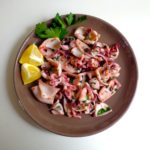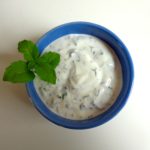 We just returned from a week at the shore in southwest France, where the beaches are vast, the waves are impressive and the food is fantastic. One of the specialties I most love in that corner of the world is squid grilled with garlic and parsley. The squid are cooked using a method the French call aller-retour, or back and forth, a phrase most commonly seen on round-trip tickets. In culinary usage, the phrase means that the food is placed on an extremely hot grill and cooked very quickly on one side (aller) and then the other (retour).
We just returned from a week at the shore in southwest France, where the beaches are vast, the waves are impressive and the food is fantastic. One of the specialties I most love in that corner of the world is squid grilled with garlic and parsley. The squid are cooked using a method the French call aller-retour, or back and forth, a phrase most commonly seen on round-trip tickets. In culinary usage, the phrase means that the food is placed on an extremely hot grill and cooked very quickly on one side (aller) and then the other (retour).
Chipirons à la plancha / Grilled squid with garlic and parsley
This dish, a Basque specialty, can be found on both sides of the nearby border with Spain, and similar versions abound around the Mediterranean. It is popular at cocktail hour, generally served with a crisp white wine, and may also be served as a starter or a main course. The key is obtaining the right kind of squid — neither too small nor too large — and that can be tricky, even in France, where the name changes according to region.
In the southwest, smallish squid, no larger than the size of a hand excluding the tentacles, are known as chipirons, a relative of the Spanish word chipirones. Moving north, the very same squid are called encornets, deriving from the horny (corné) nature of their cartilage (backbone). In Provence in the southeast, the identical squid are called supions, deriving from the Latin word sepia, or ink. Clear across France, squid, especially the larger ones, are also known as seiches, deriving from sepia, and calmars, akin to Italy’s calamari.
This dish can be prepared in just 10 minutes if you have the squid cleaned by the fishmonger before getting started. You have only to chop the squid, garlic and parsley, heat your skillet and perform a quick aller-retour. When researching this post, I learned that there’s a season for squid, which begins in August and runs through February, at least over here. The height of the season is September…
Happy cooking.

 When the French say melon, they are generally referring to one particular type of melon. It is small and round, about 4-6 inches (10-15 cm) in diameter, with dark green stripes over a pale exterior and an intoxicatingly sweet orange interior. It is similar to cantaloupe, but more fragrant. The most highly reputed come from Cavaillon, in Provence, while the most widely sold are called Charentais. All pair delightfully with duck.
When the French say melon, they are generally referring to one particular type of melon. It is small and round, about 4-6 inches (10-15 cm) in diameter, with dark green stripes over a pale exterior and an intoxicatingly sweet orange interior. It is similar to cantaloupe, but more fragrant. The most highly reputed come from Cavaillon, in Provence, while the most widely sold are called Charentais. All pair delightfully with duck. It is a mystery why the melons over here are so much sweeter than those found in the States. Perhaps because the sun in southern France is more intense, or maybe there’s another reason. If you have an idea, please let us know.
It is a mystery why the melons over here are so much sweeter than those found in the States. Perhaps because the sun in southern France is more intense, or maybe there’s another reason. If you have an idea, please let us know. When summer finally rolls around over here, our kitchen goes Mediterranean. The sultry breezes make it easy to forget that Paris is in northern France, far from the turquoise waters. Salads from Provence, Spain, Greece, Morocco and Lebanon appear, eggplant and tomatoes in many guises come to the table. And spicy meat dishes can play a starring role, for example meatballs of ground lamb topped with a yogurt sauce and fresh herbs.
When summer finally rolls around over here, our kitchen goes Mediterranean. The sultry breezes make it easy to forget that Paris is in northern France, far from the turquoise waters. Salads from Provence, Spain, Greece, Morocco and Lebanon appear, eggplant and tomatoes in many guises come to the table. And spicy meat dishes can play a starring role, for example meatballs of ground lamb topped with a yogurt sauce and fresh herbs. Dear readers of The Everyday French Chef: Normally I only post on Fridays, but today I am giving you a bonus recipe to compensate those of you who may have tried to access my site and instead found a blank page. Yes, you guessed right. My site was hacked again, and was down for about 24 hours. The problem is partially resolved now, allowing me to post this recipe for a delightfully light starter for a summer meal, or anytime of year.
Dear readers of The Everyday French Chef: Normally I only post on Fridays, but today I am giving you a bonus recipe to compensate those of you who may have tried to access my site and instead found a blank page. Yes, you guessed right. My site was hacked again, and was down for about 24 hours. The problem is partially resolved now, allowing me to post this recipe for a delightfully light starter for a summer meal, or anytime of year. A whole creamy burrata beside a nest of tender greens strewn with roasted hazelnuts and surrounded by a drizzle of raspberry sauce — I wish I had dreamt up this combination myself. But in fact I was served it at a neighborhood bistro, and have been dreaming about it ever since. The combination creates an explosion of flavors that is, frankly, kind of addictive, with the very lightly sweetened raspberry sauce as an exclamation point.
A whole creamy burrata beside a nest of tender greens strewn with roasted hazelnuts and surrounded by a drizzle of raspberry sauce — I wish I had dreamt up this combination myself. But in fact I was served it at a neighborhood bistro, and have been dreaming about it ever since. The combination creates an explosion of flavors that is, frankly, kind of addictive, with the very lightly sweetened raspberry sauce as an exclamation point. A highlight of the French summer is the rosy-cheeked apricot, which arrives from the south, generally Provence, and appears in abundance at farmers’ markets at this time of year. And a delight of the French table is a tart of apricots with almond cream. The flavors marry perfectly, the almonds adding a touch of majesty to the humble fruit. Serve it with a glass of something dry and bubbly, and prepare for applause…
A highlight of the French summer is the rosy-cheeked apricot, which arrives from the south, generally Provence, and appears in abundance at farmers’ markets at this time of year. And a delight of the French table is a tart of apricots with almond cream. The flavors marry perfectly, the almonds adding a touch of majesty to the humble fruit. Serve it with a glass of something dry and bubbly, and prepare for applause… The Basque country of southwest France is much appreciated for its culinary contributions. Across the Pyrenees in Spain, three-star chefs have taken regional cuisine to new heights of refinement. In France, Basque cooking retains its earthy traditions. The dish known as poulet basquaise sets grilled chicken on top of sautéed sweet peppers, tomatoes, onions and garlic, with a hint of spice. The result is a rustic, satisfying dish.
The Basque country of southwest France is much appreciated for its culinary contributions. Across the Pyrenees in Spain, three-star chefs have taken regional cuisine to new heights of refinement. In France, Basque cooking retains its earthy traditions. The dish known as poulet basquaise sets grilled chicken on top of sautéed sweet peppers, tomatoes, onions and garlic, with a hint of spice. The result is a rustic, satisfying dish. Peppers are popular throughout the southwest, and come in many varieties, from mild to searingly hot. They are often smaller and thinner than bell peppers. I found some Basque-style peppers at my local market last weekend when shopping for ingredients. They were red, yellow and orange. I added a green bell pepper to achieve the right color combination.
Peppers are popular throughout the southwest, and come in many varieties, from mild to searingly hot. They are often smaller and thinner than bell peppers. I found some Basque-style peppers at my local market last weekend when shopping for ingredients. They were red, yellow and orange. I added a green bell pepper to achieve the right color combination. One of the rites of spring is a trip to the market for fresh peas, which appear in abundance in June. In this recipe, the peas are blended into a textured soup enlivened with a hint of peppery mint. Serve the soup hot or cold, as is or topped with thin strips of Parma ham, a dollop of crème fraîche, a spoonful of coconut cream or finely sliced shallots and mint leaves. Meaning that this is a soup for everyone — omnivores, vegetarians and vegans.
One of the rites of spring is a trip to the market for fresh peas, which appear in abundance in June. In this recipe, the peas are blended into a textured soup enlivened with a hint of peppery mint. Serve the soup hot or cold, as is or topped with thin strips of Parma ham, a dollop of crème fraîche, a spoonful of coconut cream or finely sliced shallots and mint leaves. Meaning that this is a soup for everyone — omnivores, vegetarians and vegans. It’s been a long rainy spring. We needed a hint of summer. The solution? Eggplant gratin with homemade tomato sauce, topped with bubbly cheese. This is a lighter version of a familiar dish, also known as eggplant parmesan, because the eggplant slices are steamed instead of fried before going into the gratin dish. It’s fun to assemble — the whole family can get into the act. Add a sprig of fresh basil and voilà. Summer has arrived.
It’s been a long rainy spring. We needed a hint of summer. The solution? Eggplant gratin with homemade tomato sauce, topped with bubbly cheese. This is a lighter version of a familiar dish, also known as eggplant parmesan, because the eggplant slices are steamed instead of fried before going into the gratin dish. It’s fun to assemble — the whole family can get into the act. Add a sprig of fresh basil and voilà. Summer has arrived. ‘I do not cook, I practice art.’ These words, pronounced by the divine actress Stéphane Audran toward the end of the film Babette’s Feast, give voice to the feelings of many of us when we enter the kitchen. Such were my feelings when I set out to duplicate a dish I had recently tasted at a nearby bistro. The dish? Cod crusted with pistachios, and served alongside a creamy purée of potatoes flavored with horseradish. Simply divine…
‘I do not cook, I practice art.’ These words, pronounced by the divine actress Stéphane Audran toward the end of the film Babette’s Feast, give voice to the feelings of many of us when we enter the kitchen. Such were my feelings when I set out to duplicate a dish I had recently tasted at a nearby bistro. The dish? Cod crusted with pistachios, and served alongside a creamy purée of potatoes flavored with horseradish. Simply divine… Over the last couple of weeks, I have been on a cooking spree, revisiting dishes already on the site in order to update their photos. The first is
Over the last couple of weeks, I have been on a cooking spree, revisiting dishes already on the site in order to update their photos. The first is  The second revisited recipe is
The second revisited recipe is  I have also added a bistro classic that was long overdue —
I have also added a bistro classic that was long overdue — 

